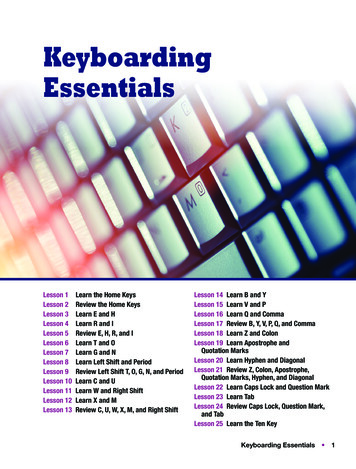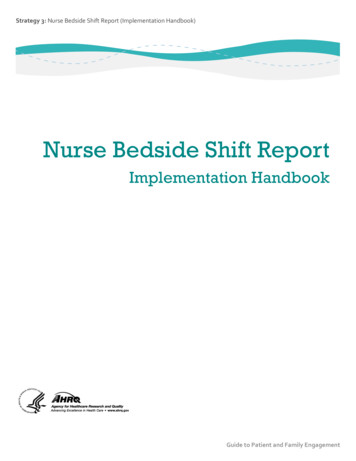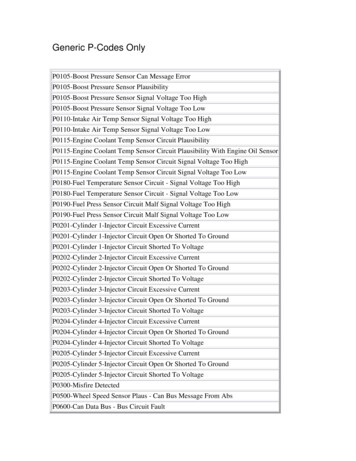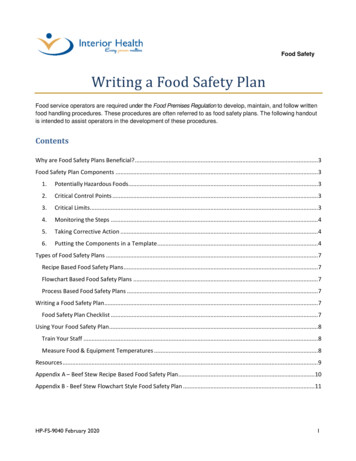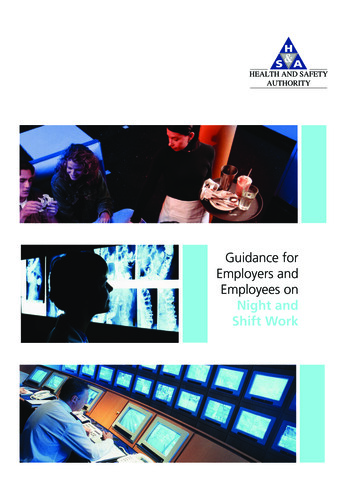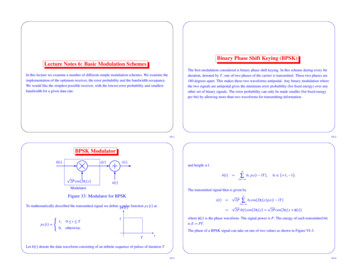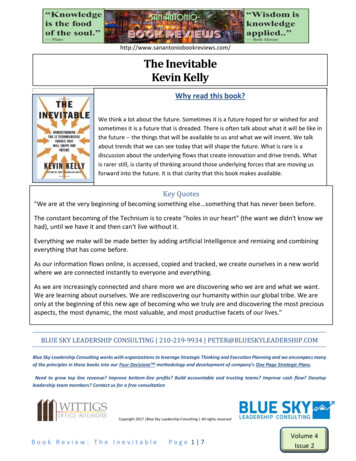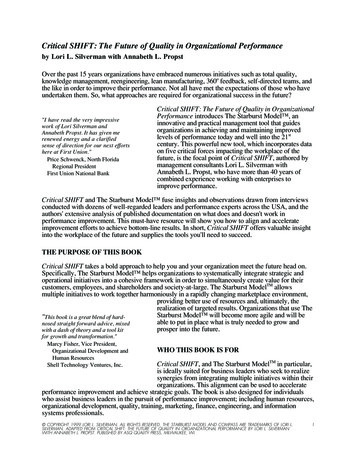
Transcription
Critical SHIFT: The Future of Quality in Organizational Performanceby Lori L. Silverman with Annabeth L. PropstOver the past 15 years organizations have embraced numerous initiatives such as total quality,knowledge management, reengineering, lean manufacturing, 360o feedback, self-directed teams, andthe like in order to improve their performance. Not all have met the expectations of those who haveundertaken them. So, what approaches are required for organizational success in the future?"I have read the very impressivework of Lori Silverman andAnnabeth Propst. It has given merenewed energy and a clarifiedsense of direction for our next effortshere at First Union."Price Schwenck, North FloridaRegional PresidentFirst Union National BankCritical SHIFT: The Future of Quality in OrganizationalPerformance introduces The Starburst Model , aninnovative and practical management tool that guidesorganizations in achieving and maintaining improvedlevels of performance today and well into the 21stcentury. This powerful new tool, which incorporates dataon five critical forces impacting the workplace of thefuture, is the focal point of Critical SHIFT, authored bymanagement consultants Lori L. Silverman withAnnabeth L. Propst, who have more than 40 years ofcombined experience working with enterprises toimprove performance.Critical SHIFT and The Starburst Model fuse insights and observations drawn from interviewsconducted with dozens of well-regarded leaders and performance experts across the USA, and theauthors' extensive analysis of published documentation on what does and doesn't work inperformance improvement. This must-have resource will show you how to align and accelerateimprovement efforts to achieve bottom-line results. In short, Critical SHIFT offers valuable insightinto the workplace of the future and supplies the tools you'll need to succeed.THE PURPOSE OF THIS BOOKCritical SHIFT takes a bold approach to help you and your organization meet the future head on.Specifically, The Starburst Model helps organizations to systematically integrate strategic andoperational initiatives into a cohesive framework in order to simultaneously create value for theircustomers, employees, and shareholders and society-at-large. The Starburst ModelTM allowsmultiple initiatives to work together harmoniously in a rapidly changing marketplace environment,providing better use of resources and, ultimately, therealization of targeted results. Organizations that use TheStarburst Model will become more agile and will be"This book is a great blend of hardable to put in place what is truly needed to grow andnosed straight forward advice, mixedprosper into the future.with a dash of theory and a tool kitfor growth and transformation."Marcy Fisher, Vice President,Organizational Development andHuman ResourcesShell Technology Ventures, Inc.WHO THIS BOOK IS FORCritical SHIFT, and The Starburst ModelTM in particular,is ideally suited for business leaders who seek to realizesynergies from integrating multiple initiatives within theirorganizations. This alignment can be used to accelerateperformance improvement and achieve strategic goals. The book is also designed for individualswho assist business leaders in the pursuit of performance improvement; including human resources,organizational development, quality, training, marketing, finance, engineering, and informationsystems professionals. COPYRIGHT 1999 LORI L. SILVERMAN. ALL RIGHTS RESERVED. THE STARBURST MODEL AND COMPASS ARE TRADEMARKS OF LORI L.SILVERMAN. ADAPTED FROM CRITICAL SHIFT: THE FUTURE OF QUALITY IN ORGANIZATIONAL PERFORMANCE BY LORI L. SILVERMANWITH ANNABETH L. PROPST. PUBLISHED BY ASQ QUALITY PRESS, MILWAUKEE, WI.1
Employees directly responsible for the quality of products and services will also become betteracquainted with a variety of tools and methods that will enhance the effectiveness of their dailywork.Educators will find Critical SHIFT and The Starburst ModelTM helpful in designing organizationalperformance and quality management courses and degree programs.OVERALL CONCLUSIONS"This book is a breakthrough in theunderstanding of what is needed totake companies to the next level ofquality management. The authorshave completed extensive researchand have presented a logical andcomprehensive roadmap for anysized company to implement aquality environment. Theyaccomplish this with a masterfulblend of insights, examples, andthought-provoking questions. TheirStarburst ModelTM encompasses allaspects of a company culture that isnecessary to insure the successfulintegration of quality."James L. Bossert, Vice President,Quality, Americas RegionNokia Mobile PhonesIn the book's introduction, three conclusions are drawnfrom the authors' research. First, the concept and practiceof quality are timeless. However, "quality," as used withinthe context of "total quality management," has fallen outof favor. While some suggest, "the quality movement isdead" because it did not produce sustainable results, thepractice of quality has, in fact, gone through a profoundmetamorphosis.Second, when this transformation is complete, the field ofquality will have fully merged with the field ofmanagement. This field will no longer function as merelythe sum of its component disciplines—human resources,accounting, finance, marketing, operations, and so forth.The new management will synthesize these areas into atotal system leading organizations to focus on providingvalue to customers, employees, and shareholders, andsociety-at-large. "Total quality management" will become"total organizational management"—what some are nowcalling "performance management," "performanceexcellence," or "operational excellence."Lastly, the inevitable result of this metamorphosis will be a reduction in the number of traditionalquality professionals. Conversely, the number of quality practitioners—those who apply qualityconcepts, tools and methods within their own work—will increase. This will occur because: Functions assumed by quality professionals (e.g., quality training) will be absorbed into otherparts of the organization. Quality activities will become a part of everyone's daily work (e.g., data collection andinterpretation). Traditional quality roles will be restructured as the transformation of quality into totalorganizational management takes hold.SECTION I: TRENDS AND FORCES AFFECTING ORGANIZATIONALPERFORMANCESection I introduces the trends and forces that are influencing the movement toward totalorganizational management and the success of performance improvement initiatives. Chapter 1presents the five critical forces shaping the workplace of the future. These forces—representedby the acronym CHAOS, describe the environment in which organizations will be operatingover the next five to ten years. They are: COPYRIGHT 1999 LORI L. SILVERMAN. ALL RIGHTS RESERVED. THE STARBURST MODEL AND COMPASS ARE TRADEMARKS OF LORI L.SILVERMAN. ADAPTED FROM CRITICAL SHIFT: THE FUTURE OF QUALITY IN ORGANIZATIONAL PERFORMANCE BY LORI L. SILVERMANWITH ANNABETH L. PROPST. PUBLISHED BY ASQ QUALITY PRESS, MILWAUKEE, WI.2
"With this book, the authors haveaddressed a gap in the quality literature by exploring the future of thequality movement, its gyrations andtransformations, and what's in storefor quality professionals and practitioners. Picking up where the ASQFuture Study leaves off, CriticalSHIFT parses the state of qualitywith the help of some of the leadingmanagement and quality thinkers,and pieces together clues of trendsand forces which will shapeorganizational performance, workand work styles, and even jobopportunities in the 21st century.This is a powerful guide forenvisioning a contour on where weare and where we're headed."Roberto M. Saco, RegionalQuality OfficerAmerican Express TRS Company Changing definition of work and theworkplace—specifically, the changing rules ofemployment and the need for a new socialcontract for employment, possible organizationaldesigns, and the era that follows the KnowledgeEconomy; Heightened social responsibility—to the planetthrough sustainability and to society throughsocial responsibility; Aging baby boomers—their impact on retirement,the economy, and the "cycle of work" mindset; Overarching demographic change—populationtrends and their impact on workplace diversity;and Strategic growth through technology andinnovation—future uses of technology and itsimpact on society, and the movement ofinnovation into daily work.Chapter 2 introduces five overarching trends that have emerged in the practice of quality as aresult of environmental forces. These trends—represented by the acronym SHIFT, areinfluencing the ways in which organizations approach performance improvement. They are: Quality goes Softer—the impact employee satisfaction has on business performance,aligning human resource systems and policies with organizational values and principles, theinfluence of organizational measures on performance, and moving beyond the basic tools ofhuman interaction;"Lori and Annabeth have examinedthe past, present, and future ofquality in a readable text. Qualityprofessionals can learn how tobecome useful in helping theirorganizations become useful. I likedit."Philip CrosbyAuthor of Quality and Me:Lessons from an Evolving Life Quality goes into Hiding—four reasons for thisphenomenon; Quality goes Integrative—the transformation ofquality to total organizational management, withan introduction to the five fields of performancepractice—Quality Assurance, Problem Resolution, Alignment and Integration, ConsumerObsession, and Spiritual Awakening; Quality goes Far-flung—the practice of qualitythroughout the world; and Quality goes Technical—what is beyond thebasic tools of quality.Together, these forces and trends are molding the initiatives that organizations are embracing toachieve required business results. COPYRIGHT 1999 LORI L. SILVERMAN. ALL RIGHTS RESERVED. THE STARBURST MODEL AND COMPASS ARE TRADEMARKS OF LORI L.SILVERMAN. ADAPTED FROM CRITICAL SHIFT: THE FUTURE OF QUALITY IN ORGANIZATIONAL PERFORMANCE BY LORI L. SILVERMANWITH ANNABETH L. PROPST. PUBLISHED BY ASQ QUALITY PRESS, MILWAUKEE, WI.3
SECTION II: EXPLORING THE STARBURST MODELTMpolityibisn OverarchingDsess&edte lesBaby Boomersging AemRSection II is the centerpiece of the book. It presents The Starburst ModelTM—the five forces ofCHAOS combined with the five fields of performance practice (see Figure 1). The StarburstModelTM meshes the concepts, tools, and methods of quality management with other tools andmethods that promote enterprise-wide performance improvement, value creation, and therequirements of the workplace of the future. mmmmmionnAlig a ti onIn n ovResolutionndl ogin ityaD efProblemC h an gi n gQualityAssurancekanoechingWornkeofaAwio nSpiritualndtheWork place wG roS tr ate gi cth ThuroghTFigure 1: The Starburst ModelTM"Critical SHIFT is a timely andinsightful guide to where organizational performance is headed andprovides the tools to succeed in theyears to come. A must read for thosewho are determined to stay on top ofwhere we are and where we aregoing in the evolution of quality."Richard Y. Chang, President andChief Executive OfficerRichard Chang Associates, Inc.1999 Chairman of the Board:American Society for Training& DevelopmentSection II introduces the model and explains thestarburst metaphor. Separate chapters are devoted toeach of the five fields of performance practice. Theydiscuss the purpose, desired outcomes, underlyingconcepts, most commonly used tools and methods,and shortcomings of that particular field (see Table1). While the concepts, tools, and methods are overviewed in the field of performance practice wherethey are first used, it is important to realize that theymay have application in other fields as well. Includedis the opportunity to evaluate your organization'sdeployment of field-specific concepts, tools, andmethods, and to address the continuing impact of theforces of CHAOS on each field of performancepractice. COPYRIGHT 1999 LORI L. SILVERMAN. ALL RIGHTS RESERVED. THE STARBURST MODEL AND COMPASS ARE TRADEMARKS OF LORI L.SILVERMAN. ADAPTED FROM CRITICAL SHIFT: THE FUTURE OF QUALITY IN ORGANIZATIONAL PERFORMANCE BY LORI L. SILVERMANWITH ANNABETH L. PROPST. PUBLISHED BY ASQ QUALITY PRESS, MILWAUKEE, WI.4
Table 1: The Five Fields of Performance PracticeElementFieldof PracticeQualityAssurancePurposeTo ensure customersreceive what they contractto receiveUnderlying Concepts ProblemResolutionTo improve bottom-lineperformance and customersatisfaction Quality nkingSDCA CycleDisciplinePDCA CycleCustomer focusVariationTeamworkCommonly Used Toolsand Methods Quality system Standardization Basic tools of quality The 5S's To ensure allorganizational workcontributes to achievingthe organization'smission, vision, and plansAlignment andIntegration AlignmentIntegrationOrganization as systemTransformationLarge-scaleorganizational changeSelf-management ConsumerObsessionTo promote long-termsurvival of theorganization Value creationOrganizational renewalMass customizationLifetime relationshipswith consumers To serve society SpiritualAwakening SpiritualityOrganization ascommunitySocial responsibilityand accountability Process managementConstraintmanagement toolsAdvanced toolsCreativity ershipsManaging the organization as a systemLarge groupinterventionsStrategic planning7 Management andPlanning ToolsProject nship marketingBrand managementNon-traditional marketresearch techniquesNew social contract foremploymentCommunity buildingSocial responsibilityauditsZero-emissionssystemsWho Desired OutcomeManagement SteeringCommitteeQuality DepartmentFront-line employees Product and serviceconformance tocustomer requirementsManagement SteeringCommitteeCross-functional(project) teamsIn-function work teamsKey customersEntire organizationSupply chain Reduced costsImprovements inperformanceImprovements incustomer mination of barriersand unnecessary workImproved overallcustomer and employeesatisfaction Current and futureconsumersEntire organizationSupply chain All individuals insociety Create value forconsumersCreate value foremployeesCreate value forshareholdersThe planet managed asa systemImproved life foreveryone on the planet COPYRIGHT 1999 LORI L. SILVERMAN. ALL RIGHTS RESERVED. THE STARBURST MODEL AND COMPASS ARE TRADEMARKS OF LORI L. SILVERMAN. ADAPTED FROM CRITICAL SHIFT:THE FUTURE OF QUALITY IN ORGANIZATIONAL PERFORMANCE BY LORI L. SILVERMAN WITH ANNABETH L. PROPST. PUBLISHED BY ASQ QUALITY PRESS, MILWAUKEE, WI.5
SECTION III: PREPARING TO USE THE STARBURST MODELTMSection III enables you to apply the five fields of performance practice in the workplace. Thefirst topic addresses the foundational skills and knowledge required in all five fields—such asverbal and written communications, acting as an agent for change, synthesis and analysis,coaching teams and individuals, helping adults learn, and using appropriate technology. It alsocovers skills and knowledge specific to each field.Several ways to go about acquiring these skills and knowledge follow this discussion. Theseinclude: ongoing education; joining and participating in professional, business, and communityassociations and organizations; what to read; the power of networking; mutual learning; andtechnology enabled learning.The final topic defines the behaviors (represented by the acronym COMPASSTM) that need tobe enacted by individuals with leadership responsibility for planning, implementing, andevaluating the five fields of performance practice ortheir individual components. They include attention to"We are tuned as consumers tothe forces impacting the workplace of the future.expecting that new is best.the old isThese behaviors are:out, the new is in. And so it goes formanagement approaches. Is quality inor out? Is reengineering better thanquality? Critical SHIFT presents uswith a more useful view; one oftransition and evolution. It guides inan evolutionary journey through past,present, and future managementapproaches, building as we go, towardeven better methods."Maury Cotter, Director, Office ofQuality ImprovementUniversity of Wisconsin-Madison Connect with change, Open up–let go, Manage polarities and meaning, Practice unwavering integrity, Attend to the whole, Serve others, and Seek self knowledge.SECTION IV: THE STARBURST MODELTM: IMPLICATIONS FOR YOURORGANIZATIONSection IV details steps organizations can take to realize benefits from the five fields ofperformance practice. It first explains how to use The Starburst ModelTM in the workplace. Thisportion provides clear-cut guidelines for applying the model to your organization andexploration questions that promote just-in-time learning. Broad-brush recommendations aregiven for three typical scenarios: organizations that have engaged in very few activities thatfocus on the concepts, tools, and methods presented in The Starburst ModelTM; organizationsthat have used a "shotgun" approach to their implementation; and organizations that havesystematically used many of the components described in the first three or four fields ofperformance practice. A discussion of commonly faced challenges in performance improvementfollows.The second half of Section IV outlines an 11-step process for configuring a department orfunction to assist management with performance improvement. Each step is presented in detailfrom determining its purpose, roles, responsibilities, and relationships with others through to itswork processes, infrastructure, and resulting employee development plans. COPYRIGHT 1999 LORI L. SILVERMAN. ALL RIGHTS RESERVED. THE STARBURST MODEL AND COMPASS ARE TRADEMARKS OF LORI L.SILVERMAN. ADAPTED FROM CRITICAL SHIFT: THE FUTURE OF QUALITY IN ORGANIZATIONAL PERFORMANCE BY LORI L. SILVERMANWITH ANNABETH L. PROPST. PUBLISHED BY ASQ QUALITY PRESS, MILWAUKEE, WI.6
SECTION V: YOUR CAREER IN ORGANIZATIONAL PERFORMANCEIMPROVEMENT"I found this book timely and helpfulfor me not only professionally, butpersonally, as I re-examine mycareer and broader life goals. Theinformation and insights offered ledme to a deeper level of self-examination and helped shed some light onimportant personal questions. TheStarburst ModelTM .helped me synthesize my thoughts into a coherentpicture of how the various pieces ofthe quality integration puzzle fit."Vern F. Campbell, P. Eng., MBAQuality CoordinatorManitoba HydroSection V presents three sets of actions that professionals who specialize in enhancing organizationalperformance can take to ensure their employability inthe workplace of the future. The first set explores anapproach for determining one's vocation, career, orjob and outlines the numerous steps involved inmaking a job and/or career change. The next setinvestigates what it means to be an external consultant. It also examines whether to join an establishedfirm, how to start a firm, and the daily challengesfaced by those who are in this role today. Section Vends with the steps for creating a personal actionplan—one that outlines what you will do differentlyin your current job and career given what you havediscovered during the course of reading this book.MEET THE AUTHORSLori L. Silverman is the owner of Partners for Progress, Madison, WI, a managementconsulting firm that helps organizations achieve and maintain a sustainable competitiveadvantage in their marketplace. She has a wide range of public- and private-sector experience instrategic management, large-scale organizational change, and total quality management, and hasauthored over 30 articles and workbooks. Silverman holds a B.S. degree in psychology and anM.S. degree in counseling and guidance, both from the University of Wisconsin-Madison, andan M.B.A. degree from Edgewood College, Madison, WI.Annabeth L. Propst is a partner at Fuller & Propst Associates, St. Charles, IL, a companyfocused on using the Theory of Constraints and other tools to help its clients develop breakthrough solutions to their problems. Propst holds a B.S. in Business and an M.S. in AppliedStatistics, both from Northern Illinois University.ORDER THE BOOK FROM THE AUTHORLori L. SilvermanPartners for Progress1218 Carpenter StreetMadison, WI 53704-4304phone: 608.241.8082fax: 608.241.8092voice mail: 800.253.6398e-mail: pfprogress@aol.com COPYRIGHT 1999 LORI L. SILVERMAN. ALL RIGHTS RESERVED. THE STARBURST MODEL AND COMPASS ARE TRADEMARKS OF LORI L.SILVERMAN. ADAPTED FROM CRITICAL SHIFT: THE FUTURE OF QUALITY IN ORGANIZATIONAL PERFORMANCE BY LORI L. SILVERMANWITH ANNABETH L. PROPST. PUBLISHED BY ASQ QUALITY PRESS, MILWAUKEE, WI.7
PUBLISHED BY ASQ QUALITY PRESS, MILWAUKEE, WI. SECTION II: EXPLORING THE STARBURST MODELTM Section II is the centerpiece of the book. It presents The Starburst ModelTM—the five forces of CHAOS combined with the five fie
